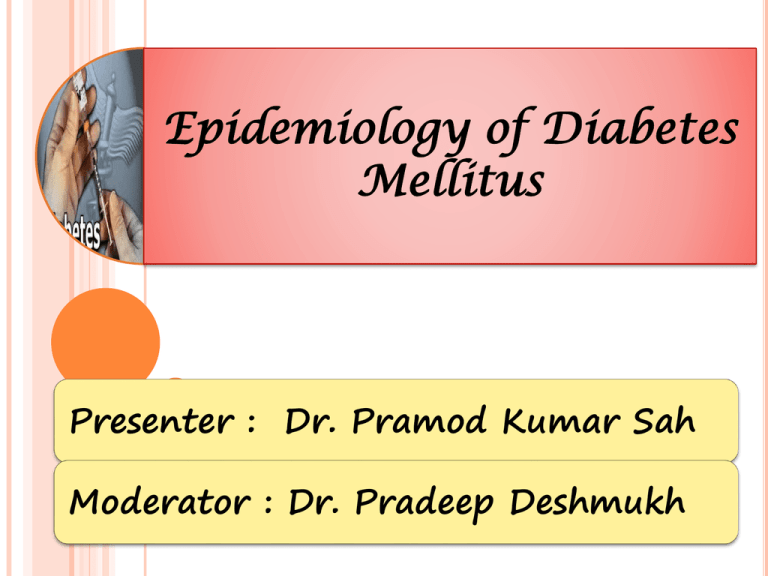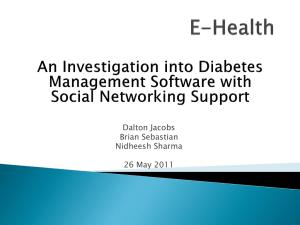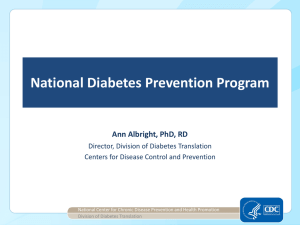
Epidemiology of Diabetes
Mellitus
Presenter
: Dr. Pramod Kumar Sah
1
Moderator : Dr. Pradeep Deshmukh
The diabetes capital of the world
2
The fact that the mostly preventable disease
diabetes has become so prevalent that is
“A Public Health Humiliation”
The Lancet editorial, volume 375, Issue 9733,
Page 2193, 26 june 2010.
3
FRAME WORK
1. Introduction
2. Burden of Disease
World,
South East region,
India,
Maharashtra,
Wardha
3. Epidemiological determinants of Diabetes
4. Evolution of Diabetes
5. prevention and Control of Diabetes
6. National programme for prevention of Diabetes.
7. Programs Initiated by Diabetes Foundation of India
4
INRTODUCTION:
India has a long history with diabetes mellitus and first
described by Charaka and Sushruta (1500 BCE).
It has been especially rapid since the 1990s and is strongly
related to lifestyle changes brought by economic transition,
industrialization, and globalization.
Becoming epidemic of diabetes places a huge burden on
individuals and families, represents a drain on health
resources, and threatens to derail the productivity, growth, and
development of the nation.
5
DEFINITION
Diabetes is a heterogeneous group of diseases,
characterized by a state of chronic hyperglycemia,
resulting
from
a
diversity
of
etiologies,
environmental and genetic, acting jointly.
6
CLINICAL CLASSIFICATION
Diabetes Mellitus (DM)
Insulin-dependent DM (IDDM, Type 1)
Non Insulin dependent DM (NIDDM, Type 2)
Malnutrition related DM (MRDM)
Impaired Glucose Tolerance (IGT)
Gestational DM (GDM)
7
CLASSIFICATION OF DIABETES MELLITUS BASED ON THE
AGE OF THE RECOGNIZED ONSET.
Infantile or child-hood diabetes: Recognised
onset between age 0 and 14 years.
Young diabetes: Recognised onset between 15
and 24 years.
Adult diabetes: Recognised onset between 25
and 64 years.
Elderly diabetes: Recognised onset over 65
years of age.
(WHO TRS)
8
Table : WHO (1999) criteria for the Diagnosis of Diabetes Mellitus
(ICMR guidelines also have the same diagnostic criteria for India)
S. NO
Categories of Hyperglycemia
1.
Diabetes Mellitus
2.
3.
Glucose Concentrations mmol/l
(mg/dl) plasma
Fasting
≥7.0 (≥126)
2-hour post glucose load (75g)
≥ 11.1 (≥200)
Impaired Glucose Tolerance
(IGT)
Fasting
<7.0 (<126)
2 hour post glucose load (75g)
≥ 7.8 (≥140) and <11.1 (<200)
Impaired Fasting Glycemia
(IFG)
Fasting
≥and <7.0 (<126) 6.1 (≥110)
2 hour post glucose load (75g)
<7.8 (<140)
9
NATURAL HISTORY OF TYPE 2 DIABETES
10
BURDEN OF DIABETES
Global burden of Diabetes
11
THE GLOBAL BURDEN
366 million people have diabetes in 2011; by 2030 this
will have risen to 552 million
The number of people with type 2 diabetes is increasing
in every country
80% of people with diabetes live in low-and middleincome countries
The greatest number of people with diabetes are between
40 to 59 years of age
183 million people (50%) with diabetes are undiagnosed
12
Diabetes caused 4.6 million deaths in 2011
GLOBAL PREVALENCE ESTIMATES, 2000
AND 2030
4.4 %
2030
2000
0.0%
2.8 %
1.0%
2.0%
3.0%
4.0%
5.0%
Reference: Wild S, Roglic G, Green A, Sicree R, King H. Global prevalence of diabetes. Diabetes Care. 2004; 27(5): 1047-1053.
Global Projections for the Diabetes
Epidemic: 2000-2030 (in millions)
EU
17.8
25.1
41%
NA
19.7
33.9
72%
LAC
13.3
33.0
248%
SSA
7.1
18.6
261%
Wild, S et al.: Global prevalence of diabetes:
Estimates for 2000 and projections for 2030
Diabetes Care 2004 In press
MEC
20.1
52.8
263%
China
20.8
42.3
204%
India
31.7
79.4
251%
World
2000 = 171 million
2030 = 366 million
Increase 213%
A+N
Z
1.2
2.014
65%
Estimated Number of People with
Diabetes Worldwide, 2010 and 2030
Country/Territory
2010
Millions
Country/Territory
2030
Millions
1 India
50.8
1 India
87.0
2 China
43.2
2 China
62.6
3 USA
26.8
3 USA
36.0
4 Russian Federation
9.6
4 Pakistan
13.8
5 Brazil
7.6
5 Brazil
12.7
6 Germany
7.5
6 Indonesia
12.0
7 Pakistan
7.1
7 Mexico
11.9
8 Japan
7.1
8 Bangladesh
10.4
9 Indonesia
7.0
9 Russian Federation
10.3
10 Mexico
6.8
10 Egypt
8.6
IDF Diabetes Atlas, 4th ed. ©International Diabetes Federation, 2009.
15
The Rising Prevalence of
Diabetes In Developing Countries
140
millions
120
100
80
60
40
20
0
20-44 Yrs
46-64 Yrs
1995
2025
65 Yrs
17
PREVALENCE T2DM IN INDIA (ICMR)
18
Prevalence
PREVALENCE OF T2DM IN DIFFERENT HABITATS(ICMR)
19
PREVALENCE OF T2DM IN DIFFERENT AGEGROUP(ICMR)
20
DIFFERENCE OF DIABETIC RATE AMONG
NON-DIABETIC AND DIABETIC(ICMR)
21
Wardha
Out of 7,42,736 population (>30 yr old & pregnant
mothers) screened,
Diabetes is 19,779 (2.66%).
(NPCDCS)
ESTIMATED NUMBER OF DIABETES IN INDIA
23
Factors for Rising of Diabetic Epidemic
Environmental factors
Sedentary life style
Change in food habits
Stress of Urban living
Increase in population
Increasing aging population (Longevity)
High Ethnic susceptibility
24
25
RISK FACTORS RESPONSIBLE FOR DM 2:
Non-Modifiable
Modifiable
Genetic Factor
Dyslipidaemia
Family History of
Diabetes mellitus
Hypertension
Low Birth weight
Ageing
Preventable
Obesity
Smoking
Alcohol
Stress
Physical Inactivity
Food habits
Viral infections
26
GENETIC FACTORS
Since 2007, genome-wide association studies has
catalogued around 20 genes (like TCF7L2,
HHEX, FTO, CDKAL1, SLC30A8 etc.) showing
strong association (with modest odds ratio ranges
between 1.2 to 1.5) with type2 diabetes (Sladek et
al. 2007, WTCCC 2007, Scott et al. 2007, Zeggini
et al. 2007).
Hypothesis Related to DM
A. Thrifty gene theory or Barker's hypothesis
27
FAMILY HISTORY
Viswanathan et al. 1996 in their study found
nearly 75% of the T2DM patients have first
degree family history of diabetes.
The prevalence among offspring with one
diabetic parent to be 36%, which increased to
54% when there, was a positive family history of
diabetes on the non-diabetic parental side also.
When both parents had diabetes, the prevalence
rate increased further (62%).
28
PLASMA LIPIDS AND
LIPOPROTEINS LEVEL
It has been reported by various workers that
T2DM patients have elevated levels of total
cholesterol,
LDL-Chol,
VLDL-Chol,
hypertriglyceridemia and reduced levels of
HDLChol (Laasko et al., 1987; Demant, 2001;
Petersen et al., 2002; Eschwege, 2003).
29
HYPERTENSION
In San Antonio Heart Study, the odds of incident
diabetes were 2.21 greater for individuals with
pre-hypertension than for those with normal
blood pressure (95% CI 1.63–2.98) after adjusting
for age, sex, and ethnicity (Mullican et al. 2009).
30
LOW/HIGH BIRTH WEIGHT
(INTRA-UTERINE ENVIRONMENT
EXPOSURE)
Meta-analysis done by Whincup et al. 2008 found a
combined OR of 0.75 (95% CI, 0.70-0.81) per kilogram
(increase in weight) of T2DM, adjusted for age and
sex, in the 28 populations. The inverse association
between birth weight and T2DM risk appeared graded
in all studies, particularly at birth weights of 3 kg or
less.
31
OBESITY
Meta-analysis done by Vazquez et al. 2007
demonstrated the pooled relative risks for
incident diabetes of 1.87 (95% confidence interval
(CI): 1.67-2.10), 1.87 (95% CI: 1.58-2.20), and
1.88 (95% CI: 1.61-2.19) per standard deviation of
body mass index, waist circumference, and
waist/hip ratio, respectively, demonstrating that
these three obesity indicators are the important
risk factor for diabetes.
32
PHYSICAL INACTIVITY
The protective effect of physical activity in subjects
with an excessive BMI and elevated glucose
levels; physical activity and weight control are
critical factors in diabetes prevention in subjects
with both normal and impaired blood glucose
regulation (Hu et al. 2004).
33
DIETARY HABITS
Mohan et al. 2009 found an odds ratio (OR) of 5.3
(2.98-9.45), p-vale<.001 for Refined Grains and
an OR of 0·31 (0·15, 0·62), p-vale<.001 for dietary
fiber intake (inversely related).
34
SYNERGISTIC EFFECT OF HERITABILITY AND
PHYSICAL ACTIVITY ON GLUCOSE INTOLERANCE
Chennai Urban Population Study
Family history negative
+ Physical active
Reference
Family history positive
+ Physical active
2.5 times higher risk
Family history negative
+ Sedentary
2.0 times higher risk
Family history Positive
+ Sedentary
0
3.0 times higher
risk
0.5
1
1.5
2
2.5
3
3.5
Odds ratio
Mohan V et al, J Assoc Physicians India, 51:771-777, 2003
4
35
Framingham Heart Study 30-Year Follow-Up:
CVD Events in Patients With Diabetes (Ages 35-64)
10
Men
8
Risk
ratio
Women
6
4
30
19
38
6
3*
20
2
0
Total
CVD
CHD
Stroke
Age-adjusted annual rate/1,000
P<0.001 for all values except *P<0.05.
Wilson PWF, Kannel WB. In: Hyperglycemia, Diabetes and Vascular Disease.
36
Ruderman N et al, eds. Oxford; 1992.
CARDIOVASCULAR DISEASE AND DIABETES
38
VASCULAR DISEASES IN TYPE 2 DM,
ICMR MULTICENTRIC STUDY
Vessel Disease
Large vessel disease
Coronary artery disease
Cerebrovascular disease
Pheripheral vascular disease
Small vessel disease
Retinopathy
Nephropathy
Male
8.1%
1.7%
0.6%
16.3%
15.4%
Female
4.7%
1.8%
0.2%
14.3%
13.9%
39
Chronic complications of Diabetes.
Mortality is increased by 200%
Heart disease and stroke rate is 200% to 400%.
Blindness 10 times more common in diabetes.
Gangrene and amputation of lower limbs about 20 times
more common than in non-diabetics.
Second leading cause of fatal renal disease.
Other chronic complication (neuropathy, infections and sexual
dysfunctions)
As a result of diabetes, hospitalisation expense increase
by 2 to 3 folds
(WHO expert committee on Diabetes mellitus.)
40
COST OF DIABETIC CARE
Estimated annual cost of diabetes care would be Rs.9,000 crores
and the average expenditure per patient per year would be a
minimum of Rs 5,000/-.
For an average Indian family with an adult with Diabetes, as much
as 25% of the family income may be devoted to diabetes care.
WHO
41
42
Conceptual framework of risk factors and level of
prevention and management of Diabetes mellitus:
44
TOOLS FOR IDENTIFYING RISK CATEGORY FOR T2DM
45
METHODS OF CREATING AWARENESS
46
Evidence on Prevention of
diabetes(Population Strategy)
North Karelia Project (Finland): A comprehensive
Interventions:
public health programme to prevent CVD and diabetes
by policy & environmental intervention in an effective,
community focused manner
Raised awareness among
-Local consumers
-Schools
-Social & Health services
Policy modification
-Banned tobacco advertisements
-Low fat and vegetable products
-Change in farmer’s payment scheme
-Incentives for communities achieving low cholesterol level
Lessons from UKPDS:
Better control means fewer complications
EVERY 1%
reduction in HBA1C
REDUCED RISK*
Deaths from diabetes
Heart attacks
1%
Microvascular complications
Peripheral vascular disorders
UKPDS 35. BMJ 2000; 321: 405-12
*p<0.000
1
48
National Health programme
49
National program for Prevention and control of
Cancer, Diabetes, Cardiovascular diseases and Stroke
(NPCDCS):
Launched during Eleventh five year plan (2007-2012).
NPCDCS is implemented in a phased manner with a
pilot being done in Preparatory Phase 2006-2007
The programme is being implemented in 20000
subcentres & 700 community health centres in 100
districts spread over 21 States during 2010-2012
50
CONT….
Is envisaged providing preventive, promotive, curative
and supportive services at various government health
facilities.
has the objective of risk reduction for prevention of noncommunicable chronic diseases (Diabetes, CVD and
Stroke) and early diagnosis and appropriate management
of Diabetes, Cardiovascular diseases and Stroke.
The expected outcomes for the pilot phase are awareness
generated on HEALTHY LIFE STYLES; Health
promotion at School, Community & work places;
Decrease in the incidence of Non –Communicable
Diseases particularly, Diabetes, Cardiovascular Diseases
and Stroke
51
Programs Initiated by Diabetes Foundation of India:
1. “MARG” (The Path):
Focuses on primary prevention with the aim of creating
awareness about diabetes, obesity, lipid disorders and
heart disease in children and adolescents in North India.
In order to enable children of age 9-18 years to
disseminate messages regarding healthy living to peers
and family, they are teaching children optimal dietary and
lifestyle practices for prevention of lifestyle diseases.
52
`
2. ‘CHETNA’ (Childrens’ Health Education Through
Nutrition and Health Awareness”)
Is a program which aims to impart health education on
the prevention of obesity, diabetes, and heart disease in
school children.
3.‘TEACHER’ (Trends in childhood nutrition and
lifestyle factors in India) :
Aim is to obtain an in-depth understanding of nutrition
and lifestyle behaviours that affect health and well being
of urban Indians, particularly children.
53
REFERENCES:
2008-2013 Action Plan for the Global Strategy for the Prevention and Control of No
communicable Diseases. Geneva:WHO;2008
National programme for prevention and control of cancer, diabetes, cvd and stroke (npcdcs)
–Operational Guidelines, DGHS-MOHFW
National programme for prevention and control of cancer, diabetes, cvd and stroke
(npcdcs)- Manual for Medical Officer
NCD REPORT –WHO,Chapter 1 – Burden: mortality, morbidity and risk factors
Health System Development :Primary Health care-Current Health Challenges and the way
forward
Kishore J .National Health Programmes of India. New Delhi :Century Publications, 2011
WHO TRS 310 .
The North Karelia Project: 30 years successfully preventing chronic diseases. Diabetes
voice. 2008;53: 26-9.
54
55








